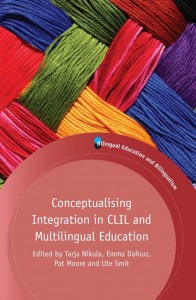Language and Content Integration: towards a conceptual framework
This project was concerned with content and language integrated learning (CLIL), an educational approach in which a language other than students’ mother tongue is used as the language of instruction. The main objective of the project was to work towards a conceptual framework of CLIL by research-based problematization of its central notions language and content and especially that of their integration.
For key findings of the project, see: Tarja Nikula, Emma Dafouz, Pat Moore & Ute Smit (eds.) (2016). Conceptualising Integration in CLIL and Multilingual Education. Bristol: Multilingual Matters.
http://www.multilingual-matters.com/display.asp?K=9781783096138
The following is a brief overview of the main findings and arguments of the project:
- The project has shown how integration as the core concern in CLIL has been poorly conceptualised and often seen in too simplistic manner as co-occurrence of ‘content’ and ‘language’ without further specifications of the nature of these entities or of the exact nature of their relationship.
- Conceptualising integration requires a reorientation in how we see ‘language’. The project has advocated a view in which the functional and contextual nature of language is foregrounded. This means that it is important to pay attention to the role of language in meaning making and knowledge construction in subject and area-specific ways.
- CLIL research needs to pay attention to integration as a much broader matter that mere language + content combination. For example, integration needs to be tackled already at the level of curricular and pedagogical planning which, obviously, requires a shared view of integration in educational institutions offering CLIL. Secondly, stakeholders’ beliefs and attitudes are an important mediating phase between stated goals of integration and their enactment in practice. The project findings have indicated that there is often a great deal of fuzziness and uncertainties in teacher orientations towards CLIL, which provides a clear message to teacher educators. Finally, a more coherent view of integration requires that it is explored at the level of concrete in-situ classroom practices. The project’s findings indicate that teachers and students are constantly engaged in negotiating language and content interfaces. However, this usually happens without explicit orientation to the role of language in meaning construction.
- Discussing the integration of ‘content’ and ‘language’ easily remains a very abstract endeavor. Therefore, research community and other stakeholders might be better served by orienting to CLIL is a matter of integrating subject and language pedagogies. This conclusion clearly points towards the need for closer research cooperation between language and subject specialists in the future.
Kielen ja sisällön yhdistäminen: kohti käsitteellistä kehystä
Hankkeessa pureuduttiin CLIL (Content and Language Integrated Learning) -opetukseen, jossa opetusta annetaan jollain muulla kuin oppilaiden äidinkielellä. CLIL-opetuksen toteutustavat ovat moninaiset ja myös sille asetetut tavoitteet voivat vaihdella suuresti. Hankkeessa lähdettiin siitä, että synteesien saavuttaminen on kuitenkin mahdollista käsitteellisellä tasolla. Päätavoitteena olikin parempi ymmärrys siitä, millä tavalla vieraskielinen opetus haastaa perinteisiä käsityksiämme kielestä, sisällöstä ja erityisesti niiden yhdistämisestä.
Hankkeen päätuloksia esitellään teoksessa Tarja Nikula, Emma Dafouz, Pat Moore & Ute Smit (toim.) (2016). Conceptualising Integration in CLIL and Multilingual Education. Bristol: Multilingual Matters.
http://www.multilingual-matters.com/display.asp?K=9781783096138

